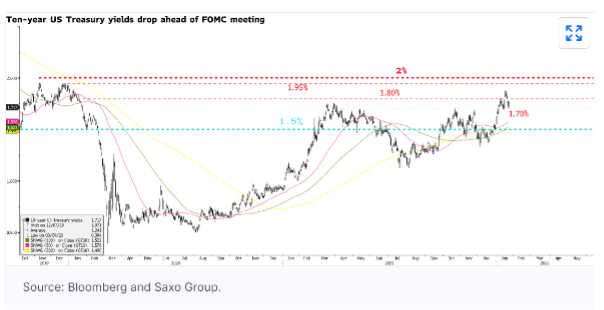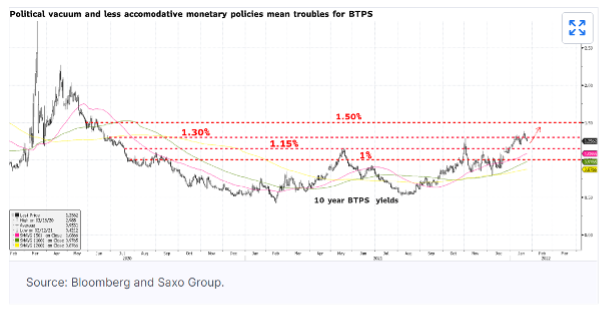How will the bond market go?

All the factors that will affect the performance of the bond market. The analysis by Althea Spinozzi, senior fixed income strategist for BG SAXO
This week's FOMC meeting will affect market sentiment globally. We believe information related to the reduction of the balance sheet is crucial to understanding how many rate hikes the Fed could implement this year. It will also provide a better picture if the yield curve continues to flatten to the downside or if there is potential for a slight steepening.
However, fears of slowing growth and escalating tensions between the US and Russia are likely to keep long-term yields compressed, hindering 10-year yields to rise to 2%. In Europe, the focus of investors will be on the Italian BTPS while the country's parliament will meet to elect the new President of the Republic. We expect volatility to rise in the process, draining demand for Italian BTPS and causing the BTPS / Bund spread to widen to 160bps.
A CRITICAL WEEK FOR US TREASURIES
This week's Federal Reserve meeting will determine sentiment across all assets with the anticipation of interest rate hikes for this year and the intentions the central bank should implement with respect to reducing its balance sheet by nearly 9 trillions of dollars. Since March 2021, the market has been pricing in four interest rate hikes. The big question is whether the Fed will match, disappoint or exceed those expectations. Let's see the three possible scenarios:
- The Fed reflects market expectations. In this case, investors' attention would shift towards the downside of its balance sheet. Suppose there are indications that the Fed's balance sheet needs to shrink faster than in previous tightening periods due to inflationary pressures. If so, we may see a concentrated sell-off on long-term Treasuries and long-duration assets, such as Tech stocks.
- The Fed goes beyond market expectations. We believe this is the least likely scenario. In this case, we will see a rapid bearish flattening of the yield curve as the market will have to evaluate a more aggressive rate hike program.
- The Fed disappoints market expectations. In this case, we could see a rise in the yield curve as the front of the yield curve will have to reconsider the number of interest rate hikes this year. The balance sheet reduction formulation will be critical as an early and aggressive start to its close could increase long-term yields, further tightening the yield curve.
Of all the options above, I believe the latter is the most likely. Indeed, the central bank has expressed concerns on several occasions about the current flat shape of the yield curve. Therefore, it would make no sense to see an overly aggressive Powell promise a rapid rate hike because that would quickly flatten the yield curve. The Federal Reserve is more likely to try to combine interest rate hikes with an early and gradual reduction in its balance sheet to preserve the steepening of the yield curve on the one hand and to tighten the economy more efficiently on the other. Through the implementation of fiscal policies, the central bank will influence long-term returns directly linked to the costs of mortgages and loans. However, if the Fed were to raise rates by 50 basis points in March, as some have suggested, it would have little impact on supply chain bottlenecks or energy prices. Let's assume that Wednesday Powell will be more likely to combine interest rate hikes with a tightening of the balance sheet. If so, the market may reconsider the number of hikes for 2022 because the central bank may not be as aggressive as expected.
However, we need to be prepared for a year when the Federal Reserve could move and change messages at every meeting. While officials were patiently trying to prove inflation was transient last year, this year they were pushed by the White House to fight it. So, let's get ready for a volatile year on the markets. Economic data will also be key for next week. On Thursday, the United States will release preliminary data on gross domestic product for the last quarter. Data on personal income and expenses for December will also be released on Friday. Numbers that could show how the economy is losing momentum, amplifying concerns about a slowdown in growth that could keep yields compressed over the long term.
We can't finish talking about Treasuries without mentioning the escalation of geopolitical tensions between the US and Russia, which caused yields to drop rapidly along the yield curve on Friday. Should tensions escalate, we can expect yields to remain compressed or even drop during a flight to safety. Yields fell further today, with 10-year yields close to testing resistance at 1.70%.

EUROPE'S PERFORMANCES SLOW DOWN THEIR RISE
In Europe, the movement of US yields will be the center of attention. If they continue to rise, they could provide momentum for Bund yields to rise above 0% again and remain above this level. Gross domestic product data for the fourth quarter of 2021 for Germany, France and Spain will be released on Friday.
THE PRESIDENTIAL ELECTIONS IN ITALY
The Italian parliament met to vote for the next President of the Republic. It is important to know that this election risks stimulating volatility among Italian government bonds. An increase in volatility has historically been linked to a decrease in investor appetite for peripheral bonds. In the more conservative scenario, we are witnessing a temporary widening of the BTP-Bund spread to 160bps. However, if Draghi leaves his post as prime minister, the country risks a political vacuum, leading the country to early elections. Not only that, but Italy's recovery also depends on funds from the Next gerneration EU fund which will not be disbursed unless the necessary reforms are implemented. Therefore, Draghi's loss as prime minister could be costly and, in the worst case scenario, the BTPS-Bund spread could widen by over 200 basis points.
However, it is important to point out that we remain bullish on the long-term BTPS-Bund spread. Indeed, both the ECB and the new German government are investing in a better integrated Europe, which in the long term will cause spreads to squeeze in the euro area.

This is a machine translation from Italian language of a post published on Start Magazine at the URL https://www.startmag.it/economia/che-cosa-influenzera-il-mercato-dei-bond/ on Tue, 25 Jan 2022 08:49:50 +0000.
